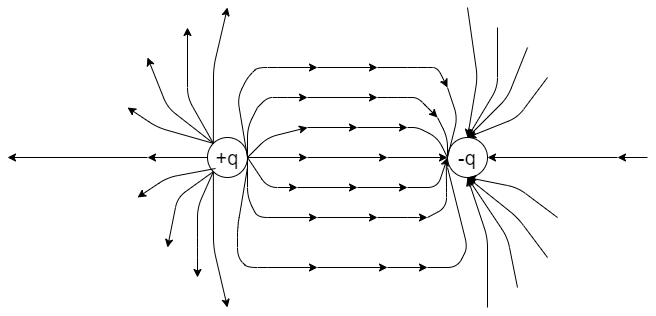
Sketch the electric field lines in case of an electric dipole.
Answer
555k+ views
Hint: Recall that in electromagnetism, electric dipole is defined as the pair of opposite charges. These charges are equal in magnitude. These charges are separated by a distance 2a. The dipole acts in a direction from charge ‘+q’ to ‘-q’.
Complete step by step answer:
Step I:
This means that the electric dipole points from positive charge to negative charge.
The strength of an electric dipole is known by dipole moment. The formula for electric dipole moment is written as:
\[p = q \times 2a\]
Where ‘p’ is the electric dipole moment
‘q’ is the magnitude of charge
‘2a’ is the distance between the charges.

Step II:
If the direction of the electric field at a particular point is to be known, then the electric field lines are used. The electric field lines emerge from a positive charge and end at the negative charge. The electric field lines for a positive charge will point in an outward direction whereas the electric field lines for a negative charge will point in an inward direction. Also the electric field lines are perpendicular to the surface of the charges and never intersect each other.
Note: It is already told that two electric field lines can never intersect each other. This is because if two electric field lines cross each other, then at the point of their intersection there will be two directions of electric field at that particular point. As two directions of electric field can never be possible, so electric field lines never cross each other. If the electric field is strong, then the electric field lines will be closer to each other.
Complete step by step answer:
Step I:
This means that the electric dipole points from positive charge to negative charge.
The strength of an electric dipole is known by dipole moment. The formula for electric dipole moment is written as:
\[p = q \times 2a\]
Where ‘p’ is the electric dipole moment
‘q’ is the magnitude of charge
‘2a’ is the distance between the charges.

Step II:
If the direction of the electric field at a particular point is to be known, then the electric field lines are used. The electric field lines emerge from a positive charge and end at the negative charge. The electric field lines for a positive charge will point in an outward direction whereas the electric field lines for a negative charge will point in an inward direction. Also the electric field lines are perpendicular to the surface of the charges and never intersect each other.
Note: It is already told that two electric field lines can never intersect each other. This is because if two electric field lines cross each other, then at the point of their intersection there will be two directions of electric field at that particular point. As two directions of electric field can never be possible, so electric field lines never cross each other. If the electric field is strong, then the electric field lines will be closer to each other.
Recently Updated Pages
Master Class 12 English: Engaging Questions & Answers for Success

Master Class 12 Business Studies: Engaging Questions & Answers for Success

Master Class 12 Economics: Engaging Questions & Answers for Success

Master Class 12 Social Science: Engaging Questions & Answers for Success

Master Class 12 Maths: Engaging Questions & Answers for Success

Master Class 12 Chemistry: Engaging Questions & Answers for Success

Trending doubts
What are the major means of transport Explain each class 12 social science CBSE

Which are the Top 10 Largest Countries of the World?

Draw a labelled sketch of the human eye class 12 physics CBSE

Explain sex determination in humans with line diag class 12 biology CBSE

Explain sex determination in humans with the help of class 12 biology CBSE

Differentiate between homogeneous and heterogeneous class 12 chemistry CBSE




